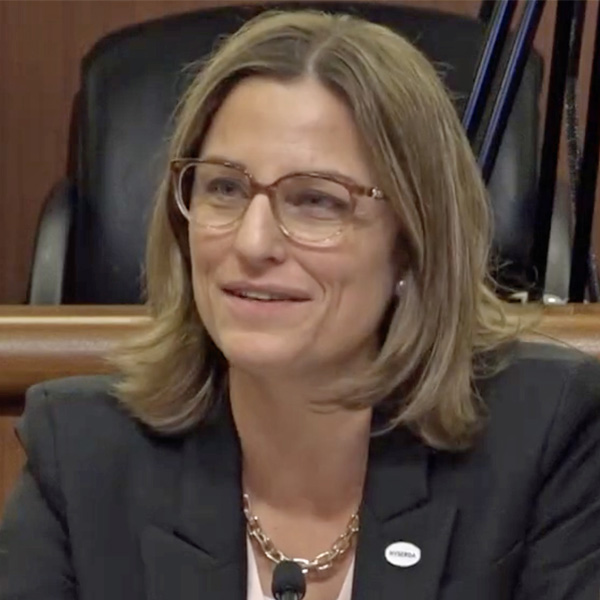SPP state regulators last week filled a leadership vacancy within the Regional State Committee by approving the Nomination Committee’s selection of Oklahoma Corporation Commission Chair Todd Hiett as its vice president.
He replaces Minnesota Commissioner John Tuma, who was to serve as the commission’s vice president this year until incoming President Will McAdams resigned from the Texas agency and the RSC last year. McAdams was elected as president during the state regulators’ October meeting, but Tuma said McAdams called him three hours after the meeting and told him he was planning to resign.
“I was elected vice president but immediately became president,” Tuma mused during the committee’s Feb. 5 meeting.
The Nebraska Power Review Board’s (NPRB) Chuck Hutchison remains the RSC’s treasurer and secretary, with Texas Commissioner Lori Cobos replacing McAdams.
McAdams officially resigned from the Texas commission in December and has since joined an Austin, Texas-based lobbying firm. He also agreed to consult with the RSC, focusing on the Resource and Energy Adequacy Leadership (REAL) Team under its chair, South Dakota Public Utilities Commissioner Kristie Fiegen. If time allows, McAdams also will work on interregional planning issues.
“He’s rolled up his sleeves and dived right into work already,” Tuma said. “I know that for a fact, because I’ve already approved the first invoice a couple of days ago.”
“I sincerely appreciate the work of the RSC leadership and of the REAL Team to allow me to continue to work on these important issues for the [load-resource entities], those utilities and stakeholders,” McAdams said. “I look forward to being able to work with you and members of the REAL Team to continue to address our large and important calendar.”
Revised RCAR Endorsed
The RSC approved the lessons learned from SPP’s third regional cost allocation review (RCAR), long a bone of contention by Missouri utilities that have felt the review’s methodology results in their benefit-to-cost ratio being unreasonably high.
The most recent RCAR, completed in 2022, left City Utilities of Springfield and Empire District Electric with B/C ratios of 14.87 and 7.99, respectively. Post-review adjustments lowered those ratios to 3.82 and 3.82, respectively.
Fiegen, who chaired the Regional Allocation Review Task Force, said after the first two reviews used “future theoretical models,” RCAR III used actual market data and compared it to the market without highway/byway projects.
“It had some unique opportunities to probably get more precise, but it also created some challenges,” she said.
Fiegen said the task force dug into years of daily market data to analyze the issue. Eventually, it determined the production cost runs in the base case and change case were accurate, but those liable for the costs were not as accurate as they were in the actual market.
The task force adjusted some of the benefits for the two utilities that “felt their benefits were overstated in our original report … to be more realistic,” Fiegen said. “Both of those entities have acknowledged these changes and found that they meet their needs.”
Commissioners unanimously approved seven recommended changes to the RCAR’s methodology and the updated RCAR 3.1.
JTIQ Backstop Funding OK’d
The committee unanimously agreed to a policy that the Department of Energy’s Grid Resilience and Innovation Partnerships (GRIP) funds be applied to offset capital costs’ allocation to load for SPP’s Joint Targeted Interconnection Queue (JTIQ) transmission portfolio with MISO. Using the DOE funds to cover the 10% allocation to load, with the balance going to generator interconnectors, the RTOs’ interregional load share will be eliminated.
NPRB’s John Krajewski, speaking for the RSC’s Cost Allocation Working Group, said subscriptions to fully fund the JTIQ projects are inadequate. He said conversations he’s had with transmission owners reveal a risk — and who bears it — if there’s not enough JTIQ participation.
“If the subscriptions don’t materialize, it’s the region that will be the backstop for any shortfalls that may occur,” he said. “For the first time, this would be a situation where we’re building projects without a guarantee of funding. The way that the tariff is currently written, the risk ends up falling back on the customers of this transmission owners who are building the projects.”
The DOE in October awarded $464.5 million in GRIP funds to MISO and SPP for their JTIQ portfolio. (See DOE Announces $3.46B for Grid Resilience, Improvement Projects.)
Last January, the RSC approved proposed cost allocations for the five projects in the portfolio. (See “Commissioners Approve 90-10 Split on JTIQ Cost Allocation,” SPP Regional State Committee Briefs: Jan. 30, 2023.)
The RSC also endorsed a pair of policy proposals related to availability and outage policies to avoid “paper resources,” Tuma said.
“We’re trying to … make sure that units that are in the workbooks, or outages that are done, are done in a way that we know what’s happening,” he said, “and that we have actual resources we know that we can count on when we’re doing our planning.”
SPP staff and the CAWG are collaborating on an “availability” definition (RR605) requiring load-responsible entities submitting deliverable or firm capacity to meet their resource adequacy requirement to certify the resource will be available and ready to perform at the accredited capacity level for the applicable season.
The REAL Team recommended prioritizing an outage policy for the winter planning resource margin while delaying additional components. The proposed policy will require any outage that is either taken or extended into the resource adequacy season without SPP’s approval to harm the LRE’s performance-based accreditation.

